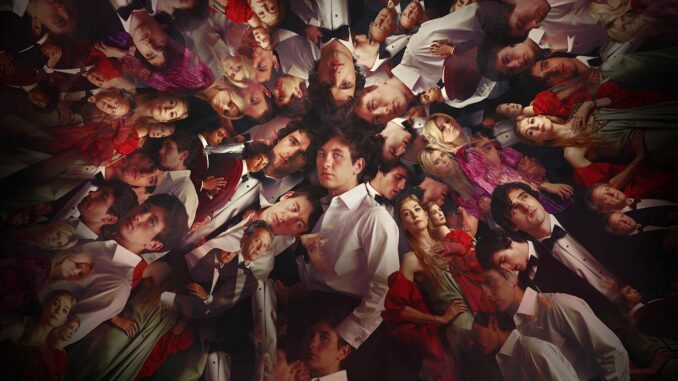
★★★★★ Exklusive Interviews
 „Das bisher schönste Interview, dass es mit mir gibt“, schrieb Eva Habermann in den sozialen Medien über diesen Artikel von FILMPULS. Und dies, nachdem sie für ihre mehr als 70 Filme und Serien in den letzten 30 Jahren über 1.000 Mal interviewt wurde.[...]
„Das bisher schönste Interview, dass es mit mir gibt“, schrieb Eva Habermann in den sozialen Medien über diesen Artikel von FILMPULS. Und dies, nachdem sie für ihre mehr als 70 Filme und Serien in den letzten 30 Jahren über 1.000 Mal interviewt wurde.[...]
 Seine Arbeit für Blockbuster wie «Titanic» (1997), oder «Avatar» (2009) hat Andrew «Andy» R. Jones zwei Oscars eingebracht. FILMPULS konnte mit dem Animation Director während seiner Arbeiten am neuesten Disney-Blockbuster[...]
Seine Arbeit für Blockbuster wie «Titanic» (1997), oder «Avatar» (2009) hat Andrew «Andy» R. Jones zwei Oscars eingebracht. FILMPULS konnte mit dem Animation Director während seiner Arbeiten am neuesten Disney-Blockbuster[...]
 Dionys Frei und Davide Tiraboschi zählen mit Dedicam zur Speerspitze im internationalen Drohnen-Business. Ihre Karriere hat Bubenträume wahr gemacht. Im Interview mit FILMPULS erzählen die beiden Schweizer über ihre Arbeit[...]
Dionys Frei und Davide Tiraboschi zählen mit Dedicam zur Speerspitze im internationalen Drohnen-Business. Ihre Karriere hat Bubenträume wahr gemacht. Im Interview mit FILMPULS erzählen die beiden Schweizer über ihre Arbeit[...]
Filmbusiness & Entertainment
 Leserfrage an Dr. Film: Ich habe eine geniale Idee für einen TV-Krimi. Leider fehlt mir die Zeit, ein Drehbuch zu schreiben – und das will ich auch nicht. Wie kann [mehr …]
Leserfrage an Dr. Film: Ich habe eine geniale Idee für einen TV-Krimi. Leider fehlt mir die Zeit, ein Drehbuch zu schreiben – und das will ich auch nicht. Wie kann [mehr …]
Gewusst wie: Video-Testimonial

Mitarbeitervideos richtig erfolgreich machen: diese 6 Punkte sind der Schlüssel dazu
Menschen investieren immer dann Aufmerksamkeit und Gefühle, wenn es um andere Menschen geht. Das ist mit ein Grund für die Kraft von Mitarbeitervideos. Dieser Artikel erklärt, auf was bei der [mehr …]

Wie du mit B-Roll Aufnahmen dein Video auf einfache Weise aufwerten kannst
Wer A sagt, muss auch B sagen. Für B-Roll Footage und Videos gilt das nur, wenn man die Anwendung dieser Art Aufnahmen auch wirklich versteht und beherrscht. Nur diesfalls entsteht [mehr …]
Videos: Bild- und Tonbearbeitung
- Fragst du einen Videotechniker, Regisseur, Cutter oder Tonmeister nach dem allerwichtigsten aller Punkte, welchen du in der Postproduktion eines Videos beachten musst, wird er dir antworten: Da gibt es hundert [mehr …]
- Sounddesign kann Atmosphäre schaffen, die Spannung erhöhen oder eine Filmszene realistischer oder abstrakter machen. Eine Sequenz, in der eine Figur durch einen Wald geht, ist viel weniger intensiv, wenn es [mehr …]
- CGI ist zu einem festen Bestandteil der Filmproduktion geworden und wird eingesetzt, um realistische Bilder zu erzeugen, die sonst unmöglich zu erreichen wären. Animationen in 2D oder 3D ermöglicht es [mehr …]
Film und Storytelling einfach erklärt

Insider
Die Kräfte hinter der globalen Popularität von erfolgreichen Actionfilmen
Actionfilme gehören zu den weltweit beliebtesten Filmen. Es gibt viele verschiedene Faktoren, die zur großen Anziehungskraft dieses Genres beitragen. Diese Art Filme ist in der Regel rasant und voller Tempo und Adrenalin, was für die [mehr …]

Fachwissen
Bewährte dramaturgische Tricks für Einsteiger in das Storytelling für Film und Video
Wenn es um Storytelling und Dramaturgie für Einsteiger in Film und Video geht, zählt nur eine Frage: Wie kann Dramaturgie dem Content zu maximaler Wirkung verhelfen? Denn nicht nur Anfang und Ende geben einer Story ihren Wert. [mehr …]

Fachwissen
Filmkonzept: diese 15 Punkte garantieren für Wirkung und Erfolg | Checkliste
Ein Filmkonzept ist die Basis für jede weitere Kreationsarbeit. Gleichzeitig muss ein Filmkonzept als Checkliste für alle Beteiligten sicherstellen, dass der Auftrag richtig verstanden wurde und sich die Umsetzung auf dem richtigen Weg befindet. [mehr …]



































